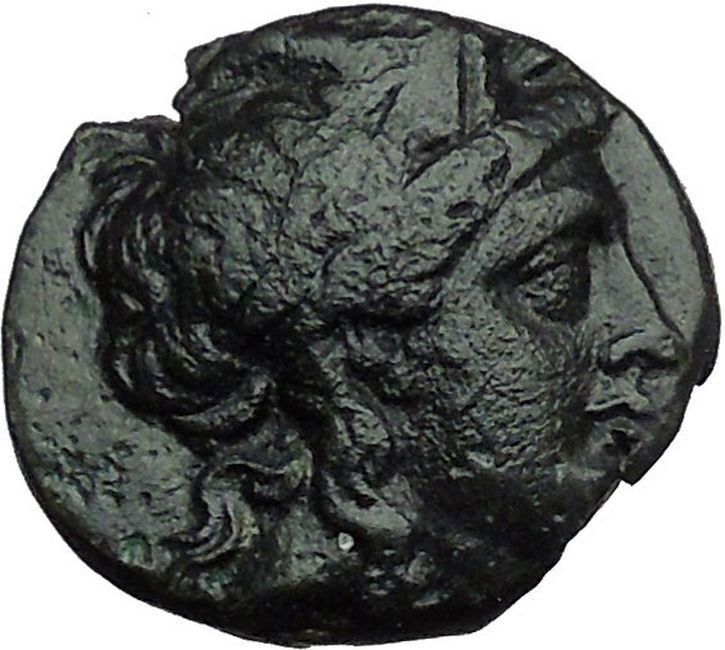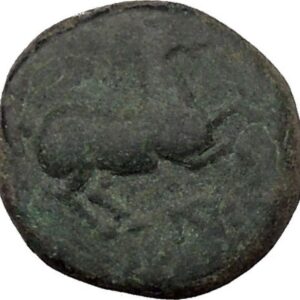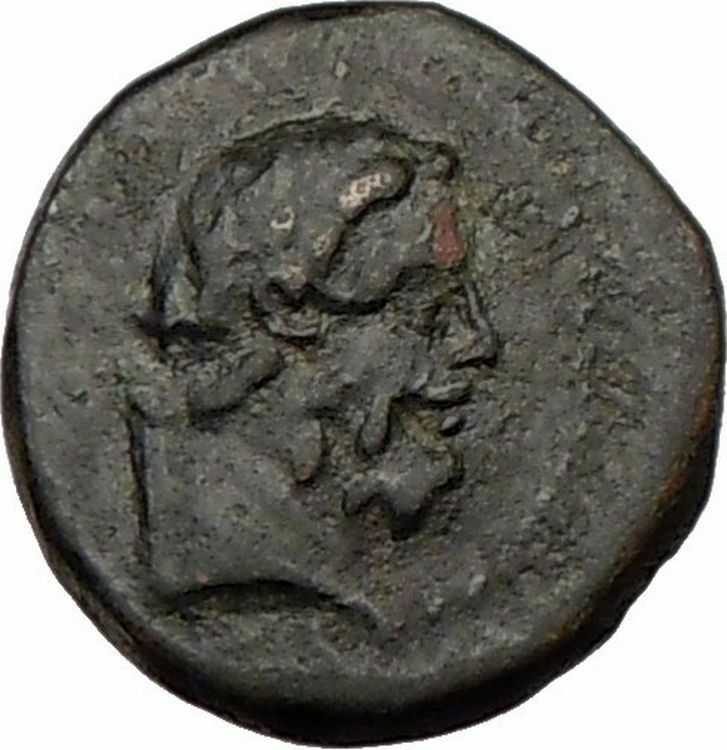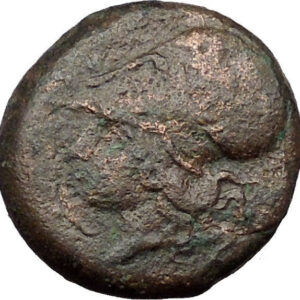|
Greek city of
Arados
in
Phoenicia
Bronze 16mm (3.26 grams) Struck circa 300-259 B.C.
Reference: Sear 5997; B.M.C.26.13,88
Turreted head of Tyche right.
Prow of galley left, with statue of fighting Athena as figurehead; above,
AP
monogram and club.
An important city of northern Phoenicia, Arados itself occupied an island but
it controlled an extensive area on the mainland.
You are bidding on the exact
item pictured, provided with a Certificate of Authenticity and Lifetime
Guarantee of Authenticity.
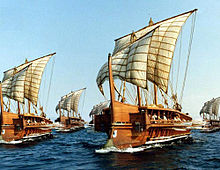
A
galley is a type of
ship propelled by
rowers
that originated in the eastern
Mediterranean Sea
and was used for
warfare
,
trade
and
piracy
from the first millennium BC. Galleys
dominated
naval warfare
in the Mediterranean from the 8th
century BC until development of advanced sailing warships in the 17th century.
Galleys fought in the wars of
Assyria
, ancient
Phoenicia
,
Greece
,
Carthage
and
Rome
until the 4th century AD. After the fall
of the
Western Roman Empire
galleys formed the
mainstay of the
Byzantine navy
and other navies of successors
of the Roman Empire, as well as new
Muslim
navies. Medieval Mediterranean states,
notably the Italian maritime republics, including
Venice
,
Pisa
,
Genoa
and the
Ottoman Empire
relied on them as the primary
warships of their fleets until the 17th century, when they were gradually
replaced by sailing warships. Galleys continued to be applied in minor roles in
the Mediterranean and the
Baltic Sea
even after the introduction of
steam propelled
ships in the early 19th
century.
The galley engagements at
Actium
and
Lepanto
are among the greatest
naval battles
in history.
Tyche (Greek for luck; the Roman equivalent was
Fortuna
) was the presiding
tutelary deity
that governed the fortune and
prosperity of a city, its destiny. Increasingly during the Hellenistic period,
cities had their own specific iconic version of Tyche, wearing a
mural crown
(a crown like the walls of the
city).

The
Greek historian Polybius
believed that when no cause can be
discovered to events such as floods, droughts, frosts or even in politics, then
the cause of these events may be fairly attributed to Tyche.
Stylianos Spyridakis concisely expressed Tyche’s appeal in a Hellenistic
world of arbitrary violence and unmeaning reverses: “In the turbulent years of
the Epigoni of Alexander
, an awareness of the
instability of human affairs led people to believe that Tyche, the blind
mistress of Fortune, governed mankind with an inconstancy which explained the
vicissitudes of the time.”
In literature, she might be given various genealogies, as a daughter of
Hermes
and
Aphrodite
, or considered as one of the
Oceanids
, daughters of
Oceanus
and
Tethys
, or of
Zeus. She was connected with
Nemesis
and
Agathos Daimon
(“good spirit”).
She was uniquely venerated at
Itanos
in Crete, as Tyche Protogeneia,
linked with the Athenian
Protogeneia
(“firstborn”), daughter of
Erechtheus
, whose self-sacrifice saved the
city.
She had temples at
Caesarea Maritima
,
Antioch
,
Alexandria
and
Constantinople
. In
Alexandria
the Tychaeon, the temple of
Tyche, was described by
Libanius
as one of the most magnificent of the
entire Hellenistic world.
Tyche appears on many
coins
of the Hellenistic period in the three
centuries before the Christian era, especially from cities in the Aegean.
Unpredictable turns of fortune drive the complicated plotlines of
Hellenistic romances
, such as
Leucippe and Clitophon
or
Daphnis and Chloe
. She experienced a
resurgence in another era of uneasy change, the final days of publicly
sanctioned
Paganism
, between the late-fourth-century
emperors
Julian
and
Theodosius I
who definitively closed the
temples. The effectiveness of her capricious power even achieved respectability
in philosophical circles during that generation, though among poets it was a
commonplace to revile her for a fickle harlot.
In medieval art
, she was depicted as carrying a
cornucopia
, an
emblematic
ship’s rudder, and the
wheel of fortune
, or she may stand on the
wheel, presiding over the entire circle of fate.
The constellation of
Virgo
is sometimes identified as the heavenly
figure of Tyche, as well as other goddesses such as
Demeter
and
Astraea
.
Arwad (Arabic:
أرواد) – formerly known as Arado (Greek:
Άραδο), Arados (Greek: Άραδος),
Arvad, Arpad, Arphad, and Antiochia in Pieria (Greek:
Αντιόχεια της Πιερίας), also called Ruad Island – located in the
Mediterranean Sea
, is the only inhabited island in
Syria
. The town
of Arwad takes up the entire island. It is located 3 km from
Tartus
, Syria’s
largest port. Today, it is mainly a fishing town. (Arados was also a Greek name
for Muharraq
near Bahrain
.)
Ancient history
The island was settled in the early 2nd millennium BC by the
Phoenicians
.
Under Phoenician control, it became an independent kingdom called Arvad or
Jazirat (the latter term meaning “island”). The Phoenician name for the city was
probably (Aynook).
In Greek it was known as Arados. The city also appears in ancient sources as
Arpad and Arphad.
The city was renamed Antiochia in Pieria by
Antiochus I Soter
. The island was important as a base for commercial
ventures into the
Orontes
valley.
Arvad was an island city off the coast of Syria some 30 miles north of
Tripolis
. It was a barren rock covered with fortifications and houses
several stories in height. The island was about 800 feet long by 500 feet wide,
surrounded by a massive wall, and an artificial harbor was constructed on the
east toward the mainland. It developed into a trading city in early times, as
did most of the Phoenician cities on this coast. It had a powerful navy, and its
ships are mentioned in the monuments of
Egypt
and
Assyria
. It
seems to have had a sort of hegemony over the northern Phoenician cities, from
the mouth of the Orontes to the northern limits of Lebanon, something like that
of Sidon in the south. It had its own local dynasty and coinage, and some of the
names of its kings have been recovered.
Its inhabitants are mentioned in the early lists of
Genesis
(10:18), and
Ezekiel
(27:8,11) refers to its seamen and soldiers in the service of
Tyre. It brought
under its authority some of the neighboring cities on the mainland, such as
Marathos
and
Simyra, the former nearly opposite the island and the latter some miles to the
south. Thutmose III
, of Egypt, took it in his campaign in north Syria (1472 BC) and
it is noticed in the campaigns of
Ramesses
II
in the early part of the 13th century BC (Breasted, Ancient Records).
It is also mentioned in the
Tell el-Amarna
Letters as being in league with the
Amorites
in
their attacks on the Egyptian possessions in Syria (44 and 28, B.M. Tell el-Amarna
Letters). About the year 1200 or later, it was sacked by invaders from Asia
Minor or the islands, as were most of the cities on the coast (Paton, Syria
and Palestine, 145) but it recovered when they were driven back. Its
maritime importance is indicated by the inscriptions of the Assyrian kings.
Tiglath-pileser I
(circa 1020) boasts that he sailed in the ships of Arvad.
Ashurnasirpal II
(circa 876) made it tributary, but it revolted, and we find
200 men of Arvad mentioned among the allies of
Hadadezer
of Aram Damascus
at the
Battle of Qarqar
, when all Syria seems to have been in league against
Shalmaneser II
(circa 854). At this time the king of Arvad was Mattan Baal.
It was afterward tributary to
Tiglath-pileser III
and
Sennacherib
, the king who paid it to the latter being Abd-ilihit (circa
701). Ashurbanipal
(circa 664) compelled its king Yakinlu to submit and send one
of his daughters to become a member of the royal harem (Rawlinson, Phoenicia,
456-57). Under the Persians Arvad was allowed to unite in a confederation with
Sidon and Tyre, with a common council at Tripolis (ibid, 484). When
Alexander the Great
invaded Syria in 332 BC Arvad submitted without a
struggle under her king Strato, who sent his navy to aid Alexander in the
reduction of Tyre. It seems to have received the favor of the Seleucid kings of
Syria and enjoyed the right of asylum for political refugees. It is mentioned in
a rescript from Rome about 138 BC, in connection with other cities and rulers of
the East, to show favor to the Jews. It was after Rome had begun to interfere in
the affairs of Judea and Syria, and indicates that Arvad was of considerable
importance at that time.
Crusades history
During the time of the
Crusades
,
the island of Ruad was used as
bridgehead
or staging area by the Crusaders, as they attempted to retake
Tortosa
after
they lost the city in 1291.
In the end of 1300, a message came from the Mongol leader
Ghazan
asking
to coordinate operations, inviting the Cypriots to meet him in Armenia.
The Cypriots then prepared a land-based force of approximately 600 men: 300
under
Amalric of Lusigan
, son of
Hugh III of Cyprus
, and similar contingents from the Templars and
Hospitallers.
The men and their horses were ferried from Cyprus to a staging area on the
island of
Ruad
, a mile off the coast of
Tortosa
.
From there, they had a certain amount of success attacking Tortosa (some sources
say they engaged in raids, others that they captured the city), but when the
hoped-for Mongol reinforcements were delayed (sources differ on whether the
delay was caused by weather or illness), the Crusaders had to retreat to Ruad.
When the Mongols still did not appear, the majority of the Christian forces
returned to Cyprus, though they left a garrison on Ruad which was manned by
rotating groups of different Cypriot forces. Pope
Clement V
formally awarded the island to the Knights Templar, and it was the
last piece of land that the Crusaders maintained in the Holy Land, as they were
fighting a losing battle against the Muslims.

A few months later, in February 1301, the Mongols did arrive with a force of
60,000, but could do little else than engage in some raids around Syria. Kutluka
(Qutlugh-Shah for the Mongols, Cotelesse in Frank sources) stationed 20,000
horsemen in the
Jordan valley
to protect Damas, where a Mongol governor was stationed.
Soon however, they had to withdraw.
The garrison on Ruad Island was being manned by Templars at the time: 120
knights, 500 bowmen and 400 Syrian helpers, under the Templar
Maréchal
(Commander-in-Chief)
Barthélemy de Quincy
. In September 1302 a Mamluk fleet landed a force,
starting the
Siege of Ruad
. The Crusaders finally had to surrender on September 26, 1302,
following a promise of safe conduct.
The promise was not honoured, and all the bowmen and Syrian helpers were killed,
and the Templar knights sent to Cairo prisons.
|








